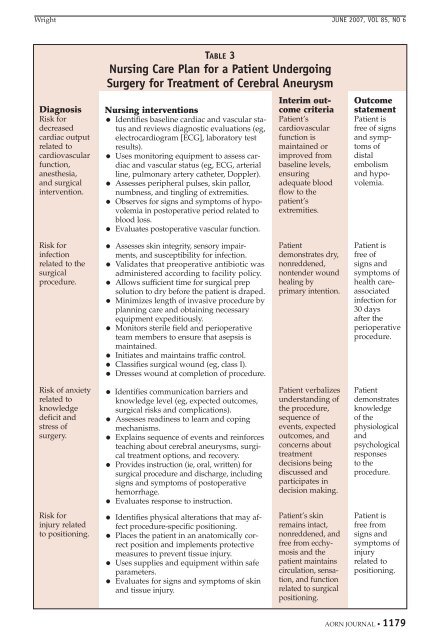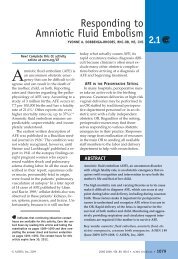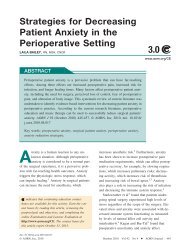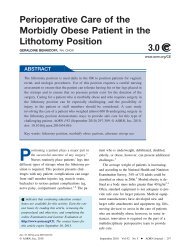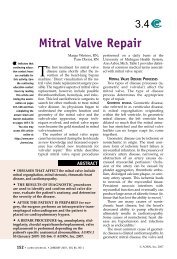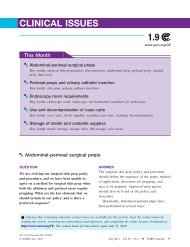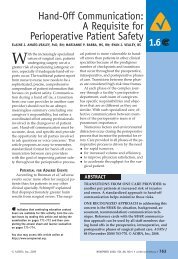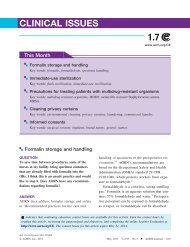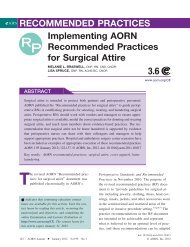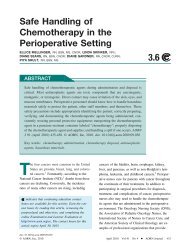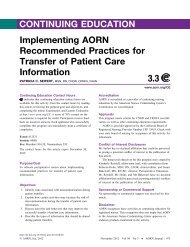Cerebral Aneurysm—Treatment and Perioperative Nursing ... - AORN
Cerebral Aneurysm—Treatment and Perioperative Nursing ... - AORN
Cerebral Aneurysm—Treatment and Perioperative Nursing ... - AORN
You also want an ePaper? Increase the reach of your titles
YUMPU automatically turns print PDFs into web optimized ePapers that Google loves.
Wright JUNE 2007, VOL 85, NO 6TABLE 3<strong>Nursing</strong> Care Plan for a Patient UndergoingSurgery for Treatment of <strong>Cerebral</strong> AneurysmDiagnosisRisk fordecreasedcardiac outputrelated tocardiovascularfunction,anesthesia,<strong>and</strong> surgicalintervention.<strong>Nursing</strong> interventions• Identifies baseline cardiac <strong>and</strong> vascular status<strong>and</strong> reviews diagnostic evaluations (eg,electrocardiogram [ECG], laboratory testresults).• Uses monitoring equipment to assess cardiac<strong>and</strong> vascular status (eg, ECG, arterialline, pulmonary artery catheter, Doppler).• Assesses peripheral pulses, skin pallor,numbness, <strong>and</strong> tingling of extremities.• Observes for signs <strong>and</strong> symptoms of hypovolemiain postoperative period related toblood loss.• Evaluates postoperative vascular function.Interim outcomecriteriaPatient’scardiovascularfunction ismaintained orimproved frombaseline levels,ensuringadequate bloodflow to thepatient’sextremities.OutcomestatementPatient isfree of signs<strong>and</strong> symptomsofdistalembolism<strong>and</strong> hypovolemia.Risk forinfectionrelated to thesurgicalprocedure.• Assesses skin integrity, sensory impairments,<strong>and</strong> susceptibility for infection.• Validates that preoperative antibiotic wasadministered according to facility policy.• Allows sufficient time for surgical prepsolution to dry before the patient is draped.• Minimizes length of invasive procedure byplanning care <strong>and</strong> obtaining necessaryequipment expeditiously.• Monitors sterile field <strong>and</strong> perioperativeteam members to ensure that asepsis ismaintained.• Initiates <strong>and</strong> maintains traffic control.• Classifies surgical wound (eg, class I).• Dresses wound at completion of procedure.Patientdemonstrates dry,nonreddened,nontender woundhealing byprimary intention.Patient isfree ofsigns <strong>and</strong>symptoms ofhealth careassociatedinfection for30 daysafter theperioperativeprocedure.Risk of anxietyrelated toknowledgedeficit <strong>and</strong>stress ofsurgery.Risk forinjury relatedto positioning.• Identifies communication barriers <strong>and</strong>knowledge level (eg, expected outcomes,surgical risks <strong>and</strong> complications).• Assesses readiness to learn <strong>and</strong> copingmechanisms.• Explains sequence of events <strong>and</strong> reinforcesteaching about cerebral aneurysms, surgicaltreatment options, <strong>and</strong> recovery.• Provides instruction (ie, oral, written) forsurgical procedure <strong>and</strong> discharge, includingsigns <strong>and</strong> symptoms of postoperativehemorrhage.• Evaluates response to instruction.• Identifies physical alterations that may affectprocedure-specific positioning.• Places the patient in an anatomically correctposition <strong>and</strong> implements protectivemeasures to prevent tissue injury.• Uses supplies <strong>and</strong> equipment within safeparameters.• Evaluates for signs <strong>and</strong> symptoms of skin<strong>and</strong> tissue injury.Patient verbalizesunderst<strong>and</strong>ing ofthe procedure,sequence ofevents, expectedoutcomes, <strong>and</strong>concerns abouttreatmentdecisions beingdiscussed <strong>and</strong>participates indecision making.Patient’s skinremains intact,nonreddened, <strong>and</strong>free from ecchymosis<strong>and</strong> thepatient maintainscirculation, sensation,<strong>and</strong> functionrelated to surgicalpositioning.Patientdemonstratesknowledgeof thephysiological<strong>and</strong>psychologicalresponsesto theprocedure.Patient isfree fromsigns <strong>and</strong>symptoms ofinjuryrelated topositioning.<strong>AORN</strong> JOURNAL • 1179


